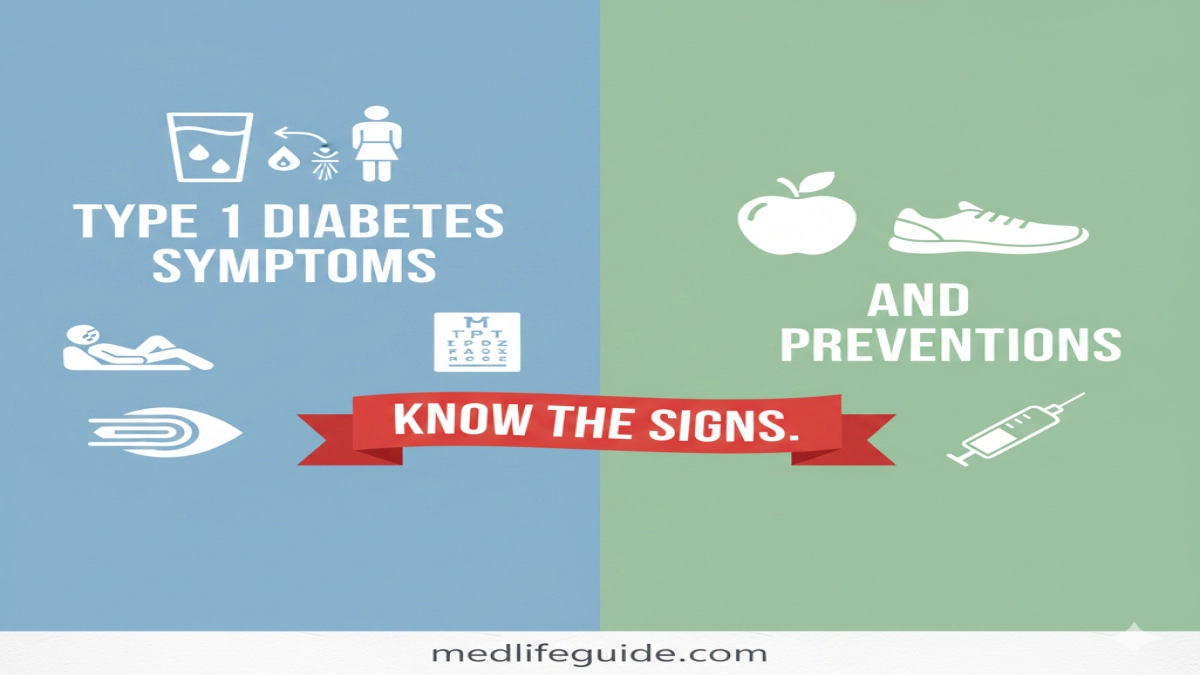Medically Reviewed and Compiled by Dr. [Adam N. Khan], MD.
Quick summary
Type 1 diabetes is an autoimmune disease where the body destroys the insulin-producing beta cells in the pancreas. It usually appears suddenly, often in children and young adults, but it can start at any age. Early recognition matters because delayed diagnosis can lead to diabetic ketoacidosis, a life-threatening emergency.Type 1 Diabetes Symptoms and Preventions
What causes type 1 diabetes?
Type 1 diabetes results when the immune system attacks pancreatic beta cells, cutting insulin production. Genetic risk and environmental triggers (viruses, early immune events) play roles, but a single clear cause is not known. Research now focuses on immune markers and early-stage disease to try to delay or prevent progression.
Common symptoms to watch for
Symptoms can come on fast over days to weeks, especially in children. Key signs:
- Increased thirst and frequent urination, including bedwetting in a previously dry child.
- Extreme hunger and unexpected weight loss despite eating more.
- Fatigue, irritability, and mood changes.
- Blurry vision.
- Nausea, abdominal pain, vomiting — these can signal diabetic ketoacidosis (DKA). Fruity-smelling breath can be a clue.
If any of these appear suddenly, get immediate medical evaluation — especially if nausea, deep rapid breathing, very low energy, or confusion are present. Those can be signs of DKA.
How is type 1 diabetes diagnosed?
Diagnosis is based on blood tests:
- Random or fasting plasma glucose and A1c (hemoglobin A1c) to measure average blood sugar.
- Autoantibody testing (GAD, IA-2, insulin autoantibodies) to confirm autoimmune type 1 disease, especially when distinguishing from type 2.
- If DKA is suspected, blood ketones, electrolytes, and acid-base tests are urgent.
Early testing is low risk and can prevent a dangerous delay.
Treatment overview (brief)
The standard treatment is insulin replacement (multiple daily injections or insulin pump) plus self-monitoring of blood glucose or continuous glucose monitoring. Education on carbohydrate counting, sick-day rules, and ketone checking saves lives. Technology (automated insulin delivery) is improving control for many people.
Prevention: what’s possible now and what’s experimental
Important distinction: classic type 1 diabetes cannot be fully prevented today in the general population. However, there are evidence-based advances that can delay clinical onset in people already identified as high risk.
- Lifestyle changes — No proven lifestyle change prevents type 1 diabetes. Healthy habits support overall health but do not stop the autoimmune process.
- Early detection and monitoring — Screening first-degree relatives or high-risk children for islet autoantibodies identifies presymptomatic stages (stage 1 and 2). Early identification allows close monitoring and access to prevention trials.
- Immunotherapy that delays onset — Teplizumab (brand name Tzield) is an immune therapy that, when given to individuals at high risk (stage 2), has been shown to delay progression to clinical type 1 diabetes for a median of about two years in trials and is FDA approved for that specific indication. This is not a cure but the first disease-modifying therapy available.
- Primary prevention trials — Trials like POInT and oral insulin studies are testing whether early immune modulation (for example, oral insulin in genetically high-risk infants) can prevent or modify disease risk. Results are evolving; some recent trials suggest promise while full primary prevention is not yet established.
Who should be screened or considered for prevention trials?
- First-degree relatives (parent, sibling, child) of someone with type 1 diabetes.
- Children with known high-risk HLA types or based on family/clinical screening programs.
- People with multiple positive islet autoantibodies and dysglycemia are candidates for interventions like teplizumab or clinical trials.
If you have a family history, ask your primary care or an endocrinologist about islet autoantibody testing or referral to a TrialNet center.
Red flags: when to go to the emergency room
Get immediate care if you or someone with suspected diabetes has: persistent vomiting, severe abdominal pain, difficulty breathing, confusion, very low energy, or unconsciousness. These may mean DKA, which requires emergency treatment.
Unique Clinical Takeaways
These are practical, clinician-level insights and patient-centered actions beyond the basic symptom list.
1. Watch for atypical adult presentations
Type 1 diabetes in adults can look like type 2. Adults may develop symptoms slowly and be misdiagnosed. If an adult is lean, losing weight rapidly, has unexplained fatigue, or requires rapidly escalating glucose-lowering therapy, insist on autoantibody testing and consider C-peptide measurement to check insulin production. Early correct classification changes treatment and avoids dangerous assumptions about insulin needs.
Actionable: If an adult with presumed type 2 needs insulin within months of diagnosis, request GAD/IA-2 autoantibodies and a fasting C-peptide to confirm type 1 physiology.
2. Prevent DKA with simple home protocols
Families often miss early DKA signs. Teach a short, practical sick-day checklist: check capillary ketones when glucose >250 mg/dL or with vomiting; follow clear rules for extra (correction) insulin; stay hydrated; call the care team early. This reduces ER visits and severe DKA. Clinically, having a written, rehearsed plan cuts response time.
Actionable: Create a one-page “If sick” protocol with your diabetes team that states when to test ketones, how to correct insulin, and when to call 911.
3. For families: connect screening with prevention opportunities
If a child has a first-degree relative with type 1 diabetes, screening for autoantibodies is not just informative — it opens the door to monitoring and to therapies that can delay onset (for those who qualify). Being proactive changes outcomes; participation in research networks like TrialNet or GPPAD/POInT can offer access to prevention trials.
Actionable: Relatives should ask their pediatrician about TrialNet or local screening programs; if positive, ask about eligibility for teplizumab or other trials.
4. Expect and use emerging options but weigh tradeoffs
Teplizumab delays clinical diabetes but carries immune-related risks and high cost. For families, the decision to use an immune therapy depends on risk tolerance, access, and detailed counseling. Clinicians should present absolute risk reduction, likely delay in years, and side effect profiles, not just relative benefits.
Actionable: Ask for a shared decision document from the prescribing center that shows expected delay (in years), side effect rates, monitoring needs, and out-of-pocket cost.
Practical prevention-minded advice for patients and families
- If there is family history, get screened for islet autoantibodies. Early knowledge is actionable.
- Learn DKA warning signs and have a written sick-day plan.
- Consider referral to an endocrinologist or a TrialNet/POInT center if screening is positive. Participation in trials may offer access to therapies that delay onset.
- Keep general health strong (vaccinations, avoid dehydration, treat infections early). These do not prevent autoimmunity but lower complication risks.
Frequently asked questions (short)
Can lifestyle changes prevent type 1 diabetes?
No proven lifestyle change prevents type 1 diabetes. Prevention efforts focus on immune-based therapies and early detection.
Is there a cure?
No. Current options can delay onset in high-risk people but do not cure established disease. Research on immune therapies and beta cell replacement continues.
Who is eligible for teplizumab?
Teplizumab is indicated for certain people identified at stage 2 type 1 diabetes (multiple autoantibodies and dysglycemia) under current approvals and clinical guidance. Determination requires specialist evaluation.
References and Citations
(Authoritative sources consulted — read these for full details)
- Centers for Disease Control and Prevention (CDC) — Symptoms of Diabetes. CDC
- American Diabetes Association — Type 1 Diabetes overview and warning signs. American Diabetes Association+1
- National Institute of Diabetes and Digestive and Kidney Diseases (NIDDK / NIH) — Type 1 Diabetes and general diabetes information. NIDDK+1
- Mayo Clinic — Type 1 Diabetes symptoms and DKA guidance. mayoclinic.org+1
- U.S. Food and Drug Administration (FDA) — Teplizumab (Tzield) approval information and press materials. U.S. Food and Drug Administration
- New England Journal of Medicine (NEJM) — Herold et al., Teplizumab trial that delayed type 1 diabetes onset. New England Journal of Medicine
- TrialNet — Teplizumab prevention study and resources for relatives at risk. TrialNet
- GPPAD / POInT and The Lancet — Primary prevention trials with oral insulin and recent POInT results. GPPAD+1
- World Health Organization (WHO) — Diabetes overview and global context. World Health Organization
Medical disclaimer
This article is for educational purposes and does not replace medical advice. If you suspect diabetes in yourself or someone else, seek prompt evaluation from a licensed health care provider or emergency care if there are signs of DKA (severe vomiting, difficulty breathing, confusion, or unconsciousness). For family screening, referral to an endocrinologist or a recognized research network (for example TrialNet or GPPAD/POInT) will provide individualized assessment and access to prevention options.

